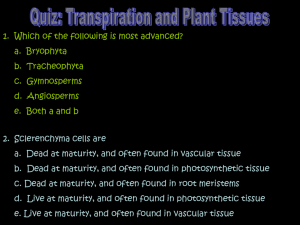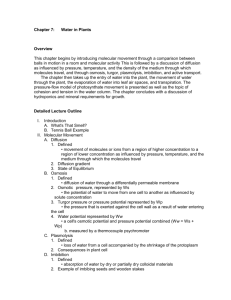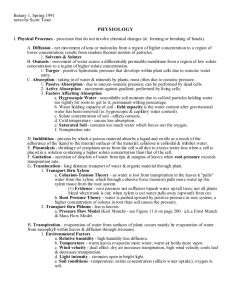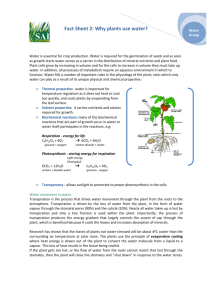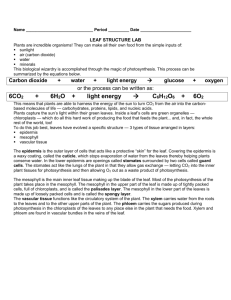Focus Question: What are the structures that allow water... vascular plant? Procedure, Part 1:
advertisement
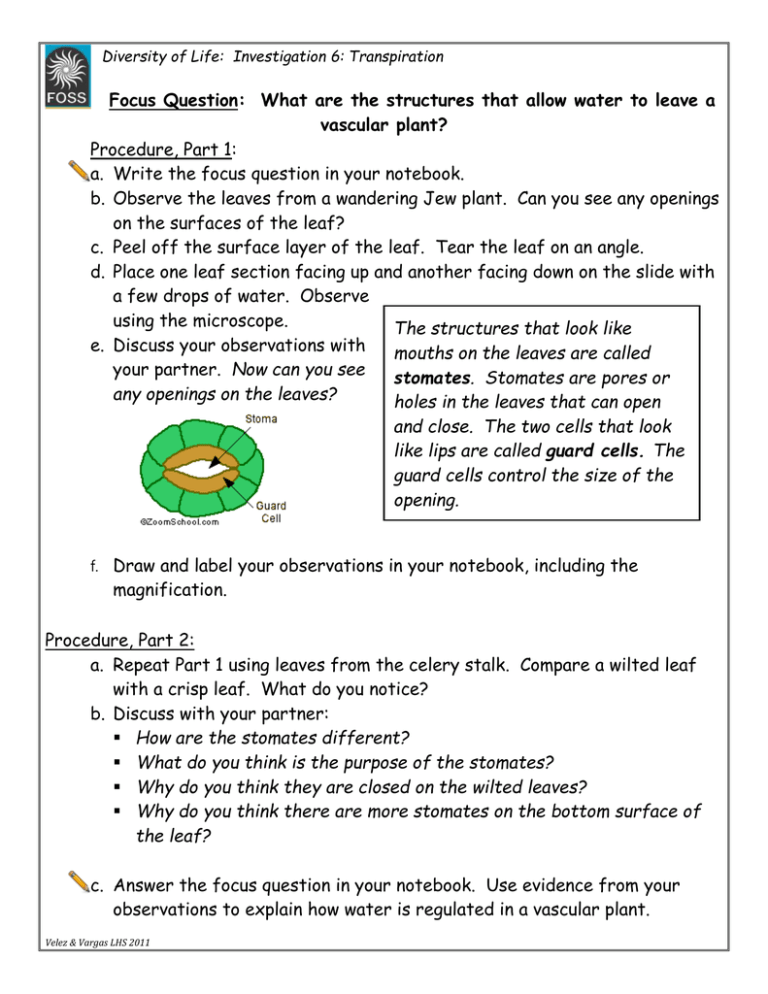
Diversity of Life: Investigation 6: Transpiration Focus Question: What are the structures that allow water to leave a vascular plant? Procedure, Part 1: a. Write the focus question in your notebook. b. Observe the leaves from a wandering Jew plant. Can you see any openings on the surfaces of the leaf? c. Peel off the surface layer of the leaf. Tear the leaf on an angle. d. Place one leaf section facing up and another facing down on the slide with a few drops of water. Observe using the microscope. The structures that look like e. Discuss your observations with mouths on the leaves are called your partner. Now can you see stomates. Stomates are pores or any openings on the leaves? holes in the leaves that can open and close. The two cells that look like lips are called guard cells. The guard cells control the size of the opening. f. Draw and label your observations in your notebook, including the magnification. Procedure, Part 2: a. Repeat Part 1 using leaves from the celery stalk. Compare a wilted leaf with a crisp leaf. What do you notice? b. Discuss with your partner: How are the stomates different? What do you think is the purpose of the stomates? Why do you think they are closed on the wilted leaves? Why do you think there are more stomates on the bottom surface of the leaf? c. Answer the focus question in your notebook. Use evidence from your observations to explain how water is regulated in a vascular plant. Velez & Vargas LHS 2011 Language Objective: Students observe the openings on leaves using a microscope, compare leaves of different conditions, and build an explanation and a model to describe how water is regulated in plants through transpiration. Vocabulary: Transpiration Xylem Capillary Action Water molecules Evaporation Stomate Guard cells English Language Development: Review with students: Stomates are openings on leaves that are controlled by guard cells. Stomates open and close to regulate the rate of transpiration. Students record the differences between the stomates in the wilted leaves and the crisp leaves. They use the information to write a summary statement explaining the function of the stomates in plant transpiration. For students who need scaffolding, provide sentence frames such as: The stomates on the wilted celery leaves are ____________, The stomates on the crisp celery leaves are ___________. I think they are different because ______________. The purpose of the stomates is to ______________. Essential Question: What are water’s unique physical and chemical properties? Application at Grade 7: How does water move through vascular plants? How does water interact with living things? TEKS for Life Science: investigate and explain how internal structures of organisms have adaptations that allow specific functions such as gills in fish, hollow bones in birds, or xylem in plants; differentiate between structure and function in plant and animal cell organelles, including cell membrane, cell wall, nucleus, cytoplasm, mitochondrion, chloroplast, and vacuole; observe and describe how different environments, including microhabitats in schoolyards and biomes, support different varieties of organisms TEKS for ELL’s: Vocabulary needs to be taught in the context of connected discourse so that language is meaningful; At the same time ELL’s are learning in English, the focus is on academic English, concepts, and the language structures specific to the content. Investigation Materials: 2 Wandering Jew leaves microscope glass slides droppers 1 stalk of celery with leaves Velez & Vargas LHS 2011
